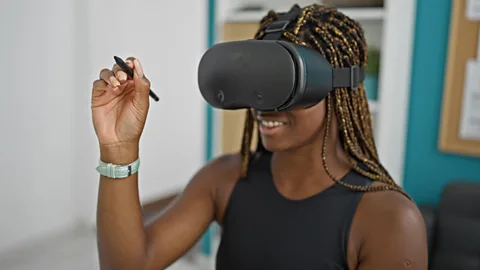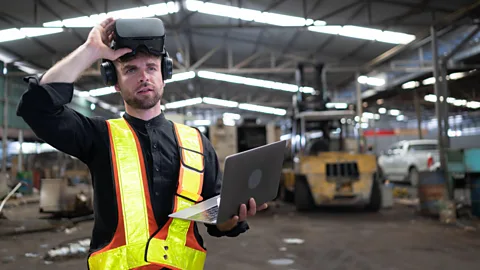Can AR and VR finally disrupt the exhausting culture of video meetings?
 Alamy
AlamySome companies touted virtual and augmented reality as the new frontier of the office. It hasn't materialised. But XR tech still may have a role to play in the modern hybrid workplace.
Jussi Havu, CEO of Helsinki-based Glue Collaborations, starts every Monday morning mingling with 30 of his colleagues in a virtual-reality meeting room. Glue's mission is to bring VR to the typical knowledge-work office. Havu is unsurprisingly optimistic about the business case for it. "There is business to be chased on this," he says.
For millions of office workers forced to relocate from their cubicles to their couches in 2020, video calls became daily drudgery. Some workers felt alienated from their teams and exhausted by back-to-back meetings, while managers worried the autonomy granted by videoconferencing threatened productivity.
Extended reality – XR – soon popped up to smooth the downsides of videoconferencing. This umbrella term refers to several different ways of viewing digital environments. With augmented reality, for instance, participants use translucent lenses that superimpose virtual sights (say, a whiteboard) onto the real world. Virtual reality creates a completely closed off digital space, with lenses and headphones that fully immerse someone in a simulation.
Tech giants and workplace consultants alike predicted XR would soon revolutionise knowledge-work offices, becoming a massive part of workers' day-to-day experiences. According to a study from multinational professional-services company PwC in 2022, more than 500 US companies said they'd either baked VR into their businesses, or were in the process of doing so.
But, by and large, this wide-scale workplace revolution hasn't panned out. Workers aren't spending all day every day in the Metaverse. Nonetheless, several XR tech companies like Glue Collaborations say AR and VR still has their uses – and big potential – in a world where hybrid work standardised, and more than ever, employees and companies alike are looking for a seamless way to blend office and home experiences.
 Alamy
Alamy'Meaningful' meetings
One of the current most common uses of XR is for training. According to PwC, workers who received instruction using VR learned in a quarter of the time of those trained in a traditional classroom, and half the time of an online course. PwC researchers also found VR students were more confident in applying the skills they learned in-headset – potentially thanks to virtually practicing their skills in XR. "Simulation-based learning in VR gives individuals the opportunity to feel as if they've had a meaningful experience," according to the study results.
While training is an XR use case that's already paid dividends for some, other companies are touting its potential to also improve the meeting experience – particularly for small gatherings where all participants need distraction-free environments. Research shows potential: in a November 2023 study from the International Journal of Human-Computer Studies, a group using Horizon Workrooms, a Meta virtual-office platform, reported VR was useful for informal and structured meetings as well as brainstorming.
Naer, a Norwegian AR company, enables users to slip on a Meta Quest headset and step into a virtual brainstorming session with their colleagues. Regardless of whether they're in the same room or on a different continent, Naer – whose name is derived from the Norwegian word for "near" – enables everyone to mimic the experience of collaborating on a physical whiteboard.
The point of VR and AR is to try and replicate personal interactions, says Christoph Fleischmann, founder and CEO of AR office firm Arthur Technologies, told the BBC via a video call from Vienna. For French banking giant Société General, Arthur's platform enables both employees and clients to appear as animated bodies – from the waist up – at meetings, surrounded by a luxurious virtual office and jumbo-tron-sized virtual slide decks.
Frank Burkhardt, Société General's managing director and head of global market sales for Germany and Austria, says the bank's researchers find it invaluable. "It provides a lot of flexibility into how we guide our clients through complex content," he explains in a video
One of the simplest reasons why XR may work so well for remote meetings may be the single-mindedness it forces on users. Between Slack notifications, emails and other online distractions, team members joining a Zoom call to hash out ideas can quickly find their attention in competing directions. "Putting on a VR headset really removes all those distractions," says Sondre Kvam, Naer's CEO and founder.
This technology also enables users to read each other's body language to a degree typically reserved for real-life conversations – a stark contrast to the dance of constant interruptions on video calls. Arthur's platform also enables users to break off into side chats by simply turning their heads. "It's these thousands of small things that just make collaboration smoother and better," says Fleischmann.
VR's acceptance curve
These experts argue XR can be easier to master than video call or teleconference technology, simply because the experience is much closer to how people normally interact. Yet even if the adjustment period isn't as long and rocky, there are still barriers to widespread XR adoption – many of which have been factors since the technology's introduction.
 Alamy
AlamyPrice is still a problem. Arthur Technologies's business is centred on big multinational organisations with big budgets and complex hierarchies like Société General, the United Nations and PwC itself. Not only can these companies afford to pay for $500 (£394) headsets for employees, but the potential cost savings for company travel – as well as productivity gains – might make the investment worthwhile.
"I think we're much further ahead in building a roadmap for bigger enterprises to adopt it and have great return on investment," says Fleischmann, "than to be able to prove a highly efficient team is even more efficient and productive."
The comfort question also remains. Compared to the 1995 Forte VFX1, a VR headset that looks more like a helmet (and weighs it, too), today's Oculus line is surprisingly lightweight. That said, many people still find headsets unpleasant to wear for more than an hour or two – enough for a decently lengthy seminar or meeting, but not much more. Some XR users also report feelings of cybersickness, a series of symptoms that includes nausea and a sense of disorientation.
Some AR tools also still throw users because they aren't immersive enough. Yasra Chandio, a graduate fellow in computer engineering at the University of Massachusetts Amherst, US, explains that there is an uncanny valley effect in AR if a scene is not rendered perfectly. An apple, for example, might look perfect, but it happens to be balancing on the edge of a table in defiance of the laws of gravity. If that happens, she says, the brain knows something is off, even if a user can't explain why.
The result is a distracted user – and a loss of the benefits of AR in the workplace. "You'll be slower," explains Chandio. "Your behaviour will be changed. Physiologically, you will feel different."
And even for researchers who've been scrutinising VR and AR technology for decades, the jury is still out about how useful it really is for most day-to-day office work, especially compared to specialised, often more hands-on applications. Academics still don't fully understand the effects of AR on humans, or where the technology itself is headed. "We're not saying there is no potential," says Fatima Anwar, assistant professor of electrical and computer engineering at UMass, who also advises Chandio. "But right now, it's at a stage where we need to understand it more."
Companies are aware the technology isn't yet ready to outright replace the video-conference and messaging platforms core to remote communication. For now, at least, they're looking at XR as supplementary.
Yet that doesn't mean there isn't potential for an even larger impact in the future. In February, Apple's new Apple Vision Pro headset forAVR will be available for purchase. Fleischmann says the tech giant may have the best opportunity to mainstream XR's potential. Their design may not be perfect, he says, but Apple may be able to convince ordinary consumers rather than just tech enthusiasts to adopt the technology. Ultimately, says Havu, he expects XR in the office will be more than capable of handling immersive meetings without the bulky headsets of years past. "I think the hardware is going to become so seamless that you can just switch it on and off."
For now, even companies in the XR space say they still use traditional video-conferencing software and collaboration tools alongside their own futuristic innovations. But they're optimistic that as technology advances, their products will have an even bigger part to play in the hybrid workspace.
Update 26 Jan 13:08: Frank Burkhart's professional title has been updated
